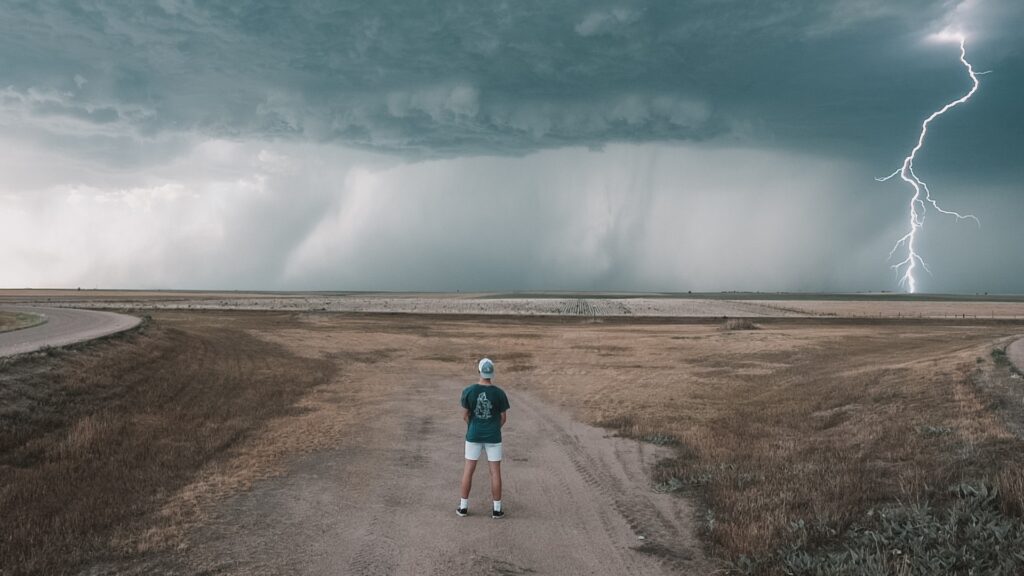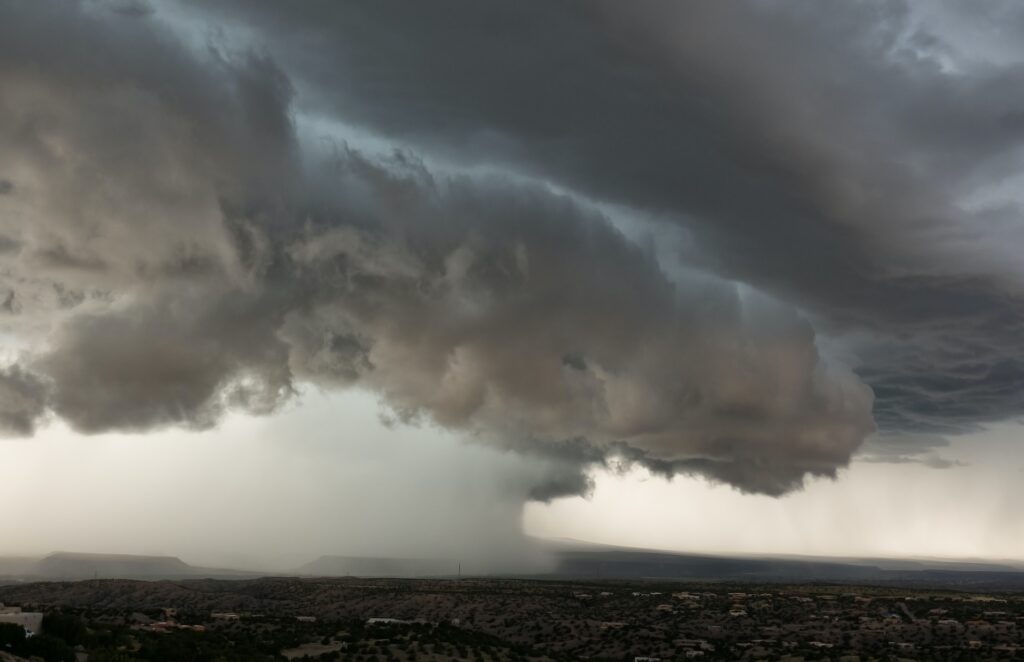Introduction to Storm Chasing
Storm chasing is an exciting pursuit that has attracted adventure enthusiasts for ages. Considered the world’s most exhilarating adventure, storm chasing involves tracking and observing severe weather events such as thunderstorms, tornadoes, and hurricanes. Storm chasers immerse themselves in the raw power of these natural forces, documenting their formation, development and the destruction they leave behind once they pass on. This article takes a deep dive into storm chasing in 2024, exploring the type of equipment you will need, the safety precautions you should take and some of the risks involved.
There are certain adventures one experiences that stay with them forever. If weather phenomena fascinate you then storm chasing is probably something you have always wanted to try. However it is crucial to approach this activity with caution and thorough preparation in order to mitigate any associated risks.
In this post, we will provide all the information you need about storm chasing, focusing on techniques to safely intercept a tornadic supercell. Make sure you read through everything carefully so as to start your preparation right.
What is Storm Chasing?
The reasons why an individual may decide to pursue a storm, especially in tornado alley, are diverse and numerous. Some people might be looking for an adventurous experience while others may want detailed information about a specific weather phenomenon or compelling material for a media narrative or even conducting scientific research.
But what drives people to go out there in those conditions?
The primary motivation that usually lies at the core of this endeavor is people’s desire to witness first hand and experience personally what it feels like when these powerful and awe inspiring storms occur.Tornadoes are some of the strongest meteorological occurrences there are, yet instead of hiding from them brave individuals find ways to approach them as closely as possible without putting their lives at risk.
This step, often involving forecasting and positioning, is extremely important and should never be ignored when planning a chase day. Spend a lot of time studying storms. Online or in the library, there’s more than enough information available for you to read. The objective is to learn as much as you can about the different kinds of storms such as tornadoes and thunderstorms. Each storm has distinct patterns and characteristics that allow meteorologists to identify them from miles away. By understanding these details, you’ll also become aware of how dangerous each storm can be.

How Do You Chase A Storm?
Are you thinking about chasing a storm? If you want to see a tornado, I’ve got some advice for you. First things first, understand this is dangerous and don’t just rush into it. Learn as much as you can before taking that leap. In order to chase storms the right way — effective and safely — I’ve put together a list of useful tips that will surely help you on your journey.
See also: Which State Has the Most Tornadoes and Why It Matters
1.Conduct Research
The first step here is to conduct some research, and it’s a very crucial one that you really wouldn’t want to take lightly. Be prepared to spend a considerable amount of time digging your head into the seemingly infinite pool of knowledge and information that the world has already in store for you on this subject matter. The internet is your friend here, but also don’t forget about all the books and articles lying around in your local library.
You should be reading as much as possible regarding storms. It doesn’t matter whether it’s an online blog post or a published book by some highly acclaimed author; just make sure you’re gathering all the necessary data available out there concerning storms, their types, patterns, characteristics — everything! This step will help familiarize yourself with the dangers and risks associated with each unique storm type out there. So whether it be tornadoes, thunderstorms or any other sort you can think of; dive right into them without hesitation.
2. Download Storm Chasing Apps
Make sure you have multiple forecast apps downloaded on your phone so that you’re well prepared when it comes time for chasing storms. Nowadays, there are a lot of powerful storm tracking applications available on the app store. In 2018, they were all recently updated too.
If you own an iPhone, then Live Chasing is perfect for you because it’s only available on iOS devices. Its best feature allows users to watch veteran chasers live during their tornado tours while taking notes for the highlight video they plan on making at home later that night.
RadarScope offers the highest level of radar detail possible on smartphones (NEXRAD Level 3), and its “Super resolution” radar data provides images with accuracy that private pilots often use to get around storms safely.
NOAA Weather Radar is compatible with both iPhones and Androids. On an interactive map, this user-friendly weather station shows real-time animated weather radar images, ensuring that no sudden changes in weather catch you off guard.
Scanner Radio was specifically designed for Android users who want to listen to live audio feeds from the weather channel during their day of chasing severe storms. It grants access to over 7,000 different scanners and radios from around the world, crucial for a successful position during a tornado intercept.
See also: What is a Waterspout Tornado?
3. Buy Storm Chasing Equipment
When you’re a beginner, there are many thrilling adventures to explore, especially when it comes to chasing after storms and the companies that offer these services. However, in order to have the most exciting experience possible in this field, you need to be equipped with the right tools. Not only will they make your experience more enjoyable but they’ll also keep you safe while out on the road.
First of all, one of the best things you can buy is a reliable tablet or laptop. These are important because they’ll act as your technological hub during your storm-chasing outings. As long as you have a sturdy car mount for them, you’ll be able access real-time weather data easily and track different storms using several apps which can enhance your storm chasing experiences.
Getting top-notch storm mapping software is an absolute must when it comes to these types of activities because it provides accurate predictions about where individual storms are headed and how bad they’re expected to get down certain parts of their paths. This allows those who use it to make informed decisions regarding whether or not they should proceed further into a storm’s path or if it’s time for them turn around and head home.
Once you’ve acquired all of the core pieces of equipment that we’ve discussed so far, now it’s time focus on some items which will help you achieve overall better footage when attempting to document severe weather events in places like The Great Plains and wherever else you plan on going during one of your world’s most exciting tornado chasing tours.
One thing many professionals will tell beginners is that a high-quality video camera is essential if they want film footage that others would find entertaining enough for them sit through without feeling bored ever even once.
A GoPro type camera might be pricy but it’s still 100% worth investing money into if someone has serious plans to start documenting moments like these during their adventures with different tour groups.
Still cameras are also highly recommended by a lot of different people who have experience going on storm chasing vacations. Snapshots serve as timeless mementos of all the action they experienced over the years and these types of photos are often cherished more than any other personal items that they’ve accumulated along their journey.
Staying connected while you’re out and about is important for everyone, regardless of what they’re doing or where they’re heading off to. Having access to the internet can be useful in so many situations, even if all you plan on using it for is communicating with others through social media or taking advantage of apps that are specifically designed for things like this.
Being prepared for anything when you’re out there on the road is crucial to your success, especially when it comes to traveling during storm chasing tours – the best moments can happen at any given time so always make sure you’re ready. There’s no way to predict how dangerous nature will get at any point throughout someone’s trip but it’s always better to be safe than sorry whenever a warning comes up on your portable weather radio and you know you need start seeking shelter as soon as possible before it’s too late.
Lastly, use some of the apps that were mentioned earlier if you haven’t already done so. They’re super helpful because not only do they provide radar imagery which can help enhance your chases but they also send severe weather alerts straight to your phone and allow users submit reports after something serious has occurred somewhere near their location out in The Great Plains.

4. Pack Wisely
Aside from all the equipment mentioned, it’s also a good idea to bring enough water and snacks with you so that you can stay hydrated and energized throughout the entire chase. The last thing you want is for your energy to fizzle out halfway through, especially since this is going to be one long pursuit in tornado alley. And speaking of long, storm chases can last anywhere from days to weeks, so make sure you have enough clothes packed as well.
Also, when planning world’s most exciting tornado tours or just any other storm chasing trip in general, don’t forget to put aside some extra cash. You never know what kind of unexpected expenses might come up along the way.
5. Join a Team
Chasing storms on your own isn’t only dangerous but it could also end up being counterproductive, which is why many turn to tour companies for guidance. With no support from others who share the same goals as you do during your vacation of a lifetime storm chasing, tackling all challenges that come with such adventures could prove impossible for one person alone.
Being part of a team ensures that there will always be people who’ve got your back and can help push you closer towards achieving those goals. Plus, if everyone brings their gear along and shares resources like equipment or even upgraded versions of each other’s gear, then things will go smoother and better results are more likely to be achieved.
Having more people around also means tasks can be assigned accordingly too — one person can drive while another keeps an eye out for nearby storm activity and yet another focuses on taking stunning photos once something forms in front of them. A division of labor like this guarantees everything important is covered while productivity remains at its highest level possible, especially crucial on a severe storm intercept mission.
Tornado Chasing
When you ask storm chasers why they do what they do, their answer is simple: to get as close as possible to a tornado. The dangerous hobby has no shortage of enthusiasts who are willing to risk it all for a chance to witness one of the most powerful forces in nature up close and personal.
Reaching wind speeds in excess of 320 miles per hour, a tornado is like nothing else on Earth. It can level entire towns within seconds and turn sturdy structures into rubble. Some people might think it’s crazy to willingly put yourself in harm’s way just for the thrill, but for storm chasers, there’s nothing more exciting.
Aside from the adrenaline rush, tornadoes also provide the perfect subject matter for photographers and videographers. They’re compact (usually no larger than 0.25 miles) and always make for great visuals. While some people might run away from a tornado, these daredevils chase after them with camera equipment in hand.
Most tornado chases happen in the United States because the country accounts for over 75% of the world’s total occurrences. If there’s one thing America is known for — besides cheeseburgers — it’s storms. The unique geographical layout makes it an ideal breeding ground for powerful twisters that can level entire cities in minutes.
So next time you hear about somebody chasing a storm down that road trip route you’ve been planning this summer, don’t be surprised if they’re smiling ear to ear when they come back with footage that looks like something out of “The Wizard Of Oz.”
All in all, the equipment used by storm chasers plays a vital role in their ability to chase storms and document them effectively. They could bring with them a high-quality camera that’s capable of capturing breathtaking images or meteorological tools that provide data crucial for understanding these powerful natural events and sharing experiences with the world.

The Fascination with Storm Chasing
Have you ever seen a tornado? I don’t mean in the movies, or on TV. But up close and personal like? It’s actually bonkers that people will pay to be part of a storm chasing tour for this reason. They’re all too eager to watch Mother Nature go nuts right before their eyes! Storm chasers are like adrenaline junkies on steroids!
Obviously they want to take the most amazing pictures and videos they can get of crazy weather events. But what kind of person actively seeks out chaos and disaster? They must really want to know how powerful and unpredictable nature can be. I couldn’t even imagine what kind of curiosity it takes to drive these folks into the heart of a storm just to document it!
See also: What is a Rain Wrapped Tornado? Severe Weather
Essential Gear for Storm Chasers
Other than those necessary devices, storm chasers also need essential gear for their safety and survival in the field. One of these gears essential for a chase day is a pair of sturdy boots, especially useful in areas prone to hail. These boots don’t only give them better footing on rough terrains but also protect their feet from sharp debris or unstable surfaces that they could step on during a chase. Another essential piece of clothing for chasing severe storms is waterproof jackets. Not only do they keep storm chasers dry during heavy rain or storms, but they also offer extra protection against harsh elements.
Helmets are must-haves too. They help shield storm chasers from any flying debris present during a storm such as hailstones or tree branches which could pose serious threats to their safety. By wearing helmets, they can reduce the risk of head injuries and ensure utmost protection.
Communication devices are also essential for storm chasers’ safety. Two-way radios let them stay connected with fellow storm chasers in tornado tours – the best so they can coordinate efforts and share information about the twister. Moreover, satellite phones provide reliable means of communication when regular phone lines are out or unreliable particularly in emergency situations when they need to call emergency services for help or assistance.
Aside from protective clothes and communication devices, well-prepared storm chasers should also carry a well-stocked first aid kit during tornado chasing tours which contains essential medical supplies like bandages, antiseptic ointments, pain relievers etc.. This first aid kit is lifesaving since it comes handy in case there were any injuries sustained during a chase. Also bring emergency food and water supplies just in case you get stranded or injured during a chase and these supplies could sustain you until help arrives.
Overall, storm chasers should ensure that they have the necessary gear to protect themselves and survive while out in the field. From your recording gear for highlight videos, protective clothes, and communication devices to first aid kits and emergency supplies, having all these gears is important for safety and well-being during a day of chasing storms.
The best storm chaser vehicles are necessary for a successful pursuit of storms. These vehicles are changed to withstand the demands of storm chasing and give you the tools and equipment needed for this endeavor. Reinforced exteriors will protect against rainstorms and flying debris, while internal modifications include brackets that are used to mount cameras and meteorological instruments. National weather compliant storm chaser vehicles typically come with advanced GPS and navigating systems so that you can safely track storms while moving through unfamiliar terrain.
Setting up a Storm Chaser Vehicle
It’s not hard to imagine the importance of a storm chaser vehicle. You can’t really chase a storm without one, so it’s pretty crucial. These are specially modified vehicles built for this purpose and have all the necessary tools and equipment.
The exteriors are reinforced to withstand just about anything that nature throws at them, including hail and flying debris. On the inside of these heavily fortified vehicles is an array of mounting brackets for cameras, meteorological instruments, or whatever else you might need to stick on there. Additionally, they come equipped with advanced GPS and navigation systems to ensure you don’t get lost in some random cow field as you’re chasing the storm of a lifetime.

Safety Precautions for Storm Chasers
While it is great to be excited about your potentially rewarding pursuit, remember that storm chasing has its own sets of risks. Put safety first always, never risk your well-being in hopes of getting a good shot at a killer tornado. Take the precautions needed to minimize any danger you may potentially find yourself in. Regularly monitor reliable sources so you have an idea of what’s coming up, be able to seek shelter during severe weather, don’t try to beat a tornado or put yourself directly in harms way— these are just some examples.
Stories of Storm Chasers Killed in the Line of Duty
Now we get into tragic stuff but important information nonetheless. People who die trying to intercept powerful twisters deserve their stories told so others can learn from their experiences and protect themselves from similar fates if they decide to pursue this as well. Veteran storm pursuers eventually lost their lives while documenting severe weather events because they were too dedicated to their passion while risking their lives for it all right in front of our eyes as witnesses. Their stories remind us about the risks that come with pursuing this dangerous art and how important it is to prioritize safety above all else.
Illinois and Indiana are known for having huge storm chasing communities. People from all over the country flock to these states, which are famous for their position in tornado alley and the intense weather conditions that create some of the most thrilling storms around. Illinois and Indiana’s tight-knit community offers a fantastic platform for collaboration among its fans. They regularly organize meet-ups, workshops, and conferences so that people can come together to share advice, experiences, and, most importantly, their love for storm chasing.
The Many Dangers of Storm Chasing
To put it simply, storm chasing is a very dangerous hobby. Even if you’re experienced, the unpredictability of storms means that your life could be in danger at any time. The high winds, lightning strikes, hail and flash floods are just a few examples of what could go wrong. And even if you do know how to handle yourself in a storm, the rapidly changing conditions can make it nearly impossible to navigate or escape from them. So while chasing storms may seem thrilling, it’s important for tourists on storm-chasing vacations to be cautious.
Making Money by Following Tornadoes
Though most people see storm chasing as an adventurous passion project, some are able to turn it into a career by 2024. Professional chasers can sell footage and images of their encounters with nature to media outlets, documentary producers and advertising agencies. However this income potential varies widely depending on experience level and reputation.
Storm Chasers in Illinois and Indiana
Illinois and Indiana have become two prime locations for aspiring storm chasers due to their unique climates and locations in the country. The communities there are also one of a kind; they thrive off providing a platform for knowledge sharing among weather enthusiasts from all over America. Regular meetups, workshops and conferences bring local chasers together so they can exchange ideas with peers who share their love for weather.
Conclusion
Storm chasing is no hobby for cowards. It demands an obsession with meteorology, a taste for adrenaline-pumping adventures, and an unwavering commitment to safety above all else. This unique pursuit allows people to witness the wrath of nature up close — an experience that will leave them in awe every time they think about it.
But storm chasers need to be extremely cautious while practicing their passion; otherwise they risk injury or even death. By staying aware of their surroundings at all times and making use of both traditional safety gear as well as a network of like-minded fans who have been in their shoes before them, they can avoid putting themselves into any unnecessary danger.

